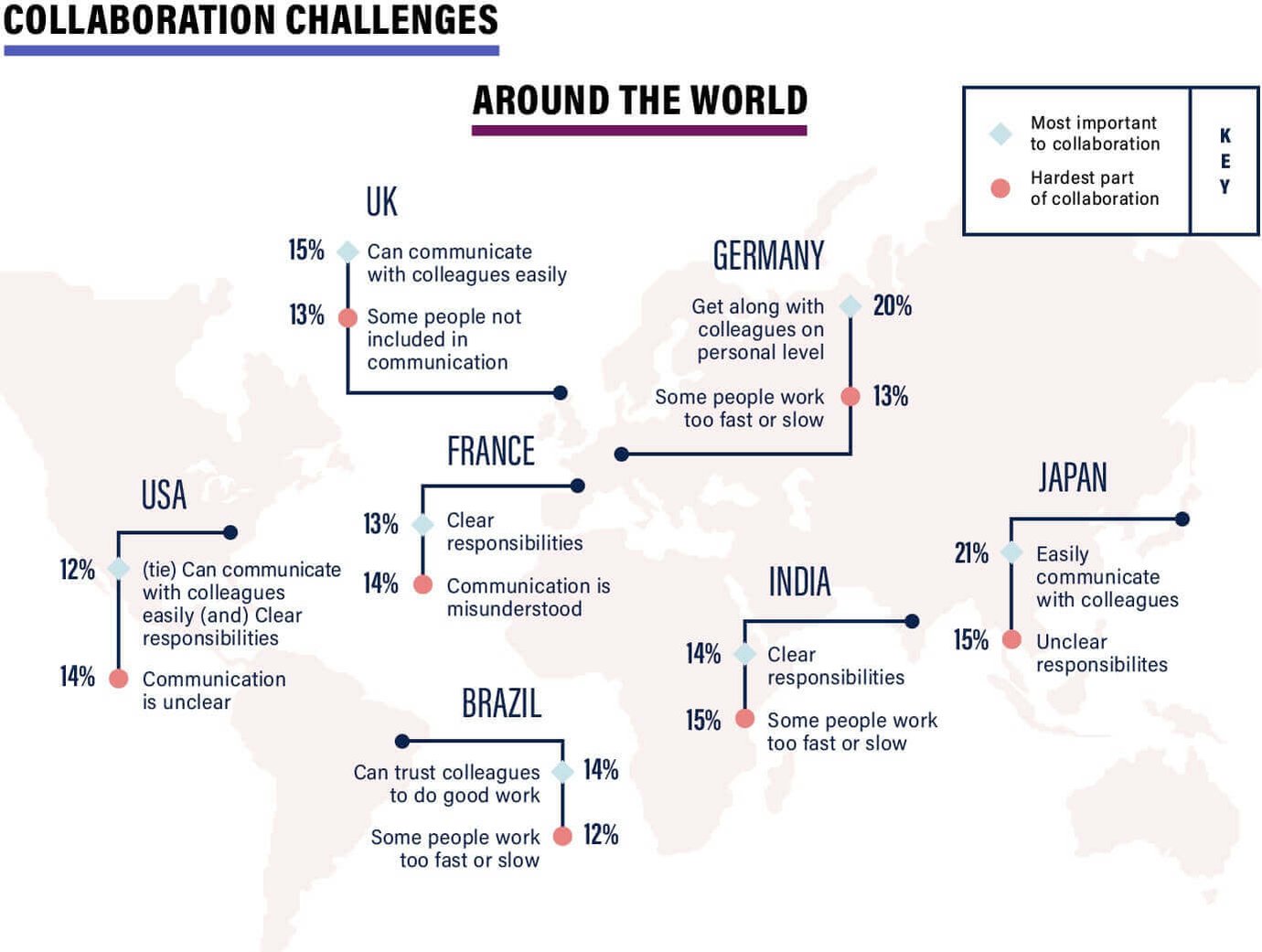Best Collaboration Tools for Teams 2023
Find the best collaboration tools for teams to help improve productivity and workflow within your company.
Cross-team collaboration is key to scaling businesses. Yet, very few organisations master it. Learn how you can empower your teams to do their best work.
Cross-team collaboration (also known as inter-team collaboration) is a key component to growing and scaling businesses successfully.
Yet, so few organisations strive for improving it and even less achieve it. What the data tells us is alarming:
And even if your employees do end up talking with members from other teams, it doesn't mean that they're communicating about the challenges that matter.
Sadly, as pleasant as casual chats are, a discussion about favourite pastimes doesn't quite compare to discussing the real problems you're having and how you should come together to solve them.
It takes a lot of work to achieve fruitful cross-functional collaboration.
But if you don't put in the effort, you risk creating misalignment in goals, information silos, and a lack of clarity that will frustrate even the most loyal and skilful employees.
Read on to better understand how you can make a meaningful improvement in how your teams collaborate with each other, not just individual contributors.
When you're ready, action those same steps to skyrocket productivity across your whole organisation - following through with just one can make a significant impact!
It seems simple: If you want to grow and make fundamental changes to your business, you'll need to take on bigger, cross-departmental projects.
But you can't complete them as successfully as you could if your teams spoke the same language and worked well together.
If you notice any of these negative signs, you're likely suffering from poor cross-team collaboration (but don't worry, we'll get into how to tackle these in a minute 😉).
The lack of good communication across teams can lead to plenty of frustration, disengagement, and wasted resources.
However, companies that invest in streamlining their processes and prioritising inter-team collaboration can reap plenty of benefits, including:
Trust, visibility, and strategic alignment are the main ingredients to making teams work well together.
According to a Harvard Business Review study, 75% of cross-functional teams are dysfunctional, and this challenge is universal across the globe.
🗺 Below is the international map of the most important and problematic parts of collaboration in the workplace, as found in Slack's knowledge worker survey. 👇

⛰ Some of the hardest challenges are linked to people not being included in essential communications or communication being generally unclear, and some people working either too fast or slow.
🔑 And when it comes to key contributors to good collaboration, ease of communication and clear responsibilities are at the top.
But with us using more project management and productivity tools with more innovative features than ever, why do we still struggle to work cross-functionally?
To increase productivity, we need to look to improving processes and systems, not people or tools.
As a celebrated management consultant, W. Edwards Deming argued in his book Out of the Crisis, 94% of most problems and possibilities for improvement belong to the system, not the individual. And this couldn't be more true when it comes to improving the output and productivity in teams.
You can't take a broken process, start using industry-leading tools, and hope that they will magically fix everything.
Leaders and managers must ensure that individual employees have the right systems in place to be able to work together without unnecessary friction.
Keeping that in mind, we're ready to move on to the essence of this article and the ways you can boost cross-functional collaboration in your organisation!

Take a holistic view of the state of collaboration at your company. Think about all the methodologies, handovers, and the way processes are designed.
Don't settle for the "it is what it is" approach and choose to investigate what's common between your most successful initiatives and your biggest mistakes.
Ask your employees to share feedback on how they team up with others and what they wish was improved. Every department you have plays a vital role in your business, and they need a shared vision to unite them and empower them to do their best work.
Carefully evaluate if you're using more tools than you need. If you see internal teams using different communication apps, it can be a red flag, and you may need to consolidate them where possible.
Employees feel much more engaged when they're aware of common objectives and how they individually fit into the big picture.
And as we'll outline below, when there's potential for a shared win in a major project, you significantly raise your chances of success.
However, your cross-functional collaboration efforts can fail magnificently if your company doesn't have a long-term vision to guide your teams forward. If you haven't already, work with your CEO, Founder(s), and leadership team to crystallise their vision and share it with everyone.
Once you have the overarching vision, each team can start creating their own strategies of how to best support it, including the product road map, growth plan, and so forth.
💡 How does this apply in the real world?
Let's say you've just announced the growth goals and main business objectives for the year. There is a clear need to generate more high-value customers, and there are several account-based marketing (ABM) and outreach techniques your sales team wants to try.
They'll definitely need help from marketing, but they'll also need to work with customer success since having more high-paying customers means more time spent on onboarding and account management. If the sales team doesn't work on timing their project, it could result in frustration, slow progress, and unsatisfied new customers.
Sounds simple: If you want to improve collaboration across teams, put forward meaningful projects with shared goals to motivate all stakeholders.
If your teams know why projects are important and how the results will benefit each of them as well as the company, they're much more likely to work effectively together.
However, taken that you have a strategy, there's still a two-fold challenge. First, you need to make sure that teams can communicate effectively. Second, you have to give your teams enough autonomy to make critical decisions and follow through with them.
To succeed, employees should be allowed to decide how they build relationships without being micromanaged. Individuals and teams alike should take full responsibility for how they'd like to work together and have an excellent self-managing process in place.
💡How does this apply in the real world?
Your support team may be looking to create new onboarding documentation for their help desk. They could do it alone or team up with the marketing team, who can improve the content quality even further.
If they agree, it would be a mutually beneficial project since it could help with trial activation and customer retention as well as improve the onboarding documentation. For this project to succeed, however, your support and marketing teams should have the autonomy to push this project forward and make it a priority.
Improving inter-team collaboration can be incredibly challenging if you don't have the buy-in from the team leads. If you're not a key stakeholder in the company, you need to look to your manager or the leadership team and raise your concerns when you see poor teamwork.
Leaders must see the relationships among the people they lead, analysing the frequency, diversity, and density of their connections. With network analysis, leaders can quantify how their leadership is experienced, both affectively and effectively. - Leadership's Digital Transformation, 2021
💡How does this apply in the real world?
Suppose you're a developer or software engineer and notice that projects either stall or get delayed because you lack input from other teams. In that case, you can look into ways of improving project management.
There's a range of processes to choose from, including Agile methodology with SCRUM, the Shape Up methodology by Basecamp, among others. Once you have the idea, you can present it to your team or manager to streamline the handover process.
Teams are more motivated and open to collaboration when they have strategic alignment AND they know what broader projects they're working on.
Things go from bad to worse when each team uses private communication channels, different tools, or doesn't communicate priorities until it's so urgent, it can't wait a day or until next week. These are called accidental information silos and you should be aware of them.
If you want better cross-functional collaboration, you need to help teams see how work happens at your company and ensure that information flows freely.
💡 How does this apply in the real world?
Make your team's work as visible as possible. Outline all significant projects and company goals they support in a project management tool that everyone has access to. Add quarterly goals with estimated deadlines to see your team's priorities and help others spot any potential opportunities to contribute.

There is always a better way of communicating with teams and employees. Following our tip #1, you should know how work is being done at your company. But how do you relay information in your day-to-day activities?
When it comes to exchanging information, there is value in real-time, high-bandwidth communication where we meet 1-on-1 or as part of a larger group. But to make information flow faster, you can employ asynchronous communication.
It perfectly fits comms much closer to admin, for example, deciding how to interact at the handover points, setting agendas, submitting work for review, and so on.
Suppose at least ⅓ of your workforce lives in different timezones. In that case, you also may need to improve how you communicate asynchronously, but don't fall into thinking that it's the silver bullet that fixes everything!
Async communication is best viewed as an integral part of your repertoire, but it's not always the “right” way of communication, and it doesn't fulfil everything when used for all comms.
💡How does this apply in the real world?
If your real-time communication is going well, and you're finding it hard to collaborate with employees located in different time zones, consider adding a tool that will simplify asynchronous communication.
While we all love Slack and it's great for talking in real-time, plenty of important decisions can get buried in long threads. Use apps that serve as major upgrades to old school intranets like Tettra, Notion, Confluence, or your favourite project management tool to log key decisions and company news.
📊Related: Take a scientific approach to understanding your workplace, so you can remove communication barriers and break down information silos. Our collaboration analytics tool (Flowtrace) helps you understand and optimise how your teams get their work done.
If you're not aware of other teams' goals and processes, it will be tough to find a common language.
It's worth spending time to learn what core methodologies teams follow - there will be one for each department, including sales, marketing, development, product, support, customer success, and so forth.
Once you know the terminology and priorities of other teams, working together towards a shared business objective will get much more straightforward.
💡How does this apply in the real world?
Create a tradition to share key business metrics every month. It can be a short, recurring call that highlights the meaning of metrics you track, past successes and challenges, as well as action points for the future.
The meeting doesn't have to be mandatory, and you can record it and share it with the company right after. It will be great for newcomers as well as senior staff as it aligns everyone on the core growth metrics and can guide teams to make better decisions on what internal projects to pursue next.
Employees can't reach peak productivity or deep focus time if they're constantly interrupted by meetings, or worse yet, by meetings where they don't have much to contribute!
There's definitely value in having recurring meetings (we mentioned one just above), but you may need to review which (if any) should be mandatory to attend. Make sure to evaluate the length of your meetings too, and see if you can shorten any with better prep beforehand.
💡How does this apply in the real world?
Let's say you're a product manager and your company's customer-facing teams run a recurring stand-up every day to stay on track with their work. While it may be beneficial to be aware of burning customer issues, it's unlikely it makes sense for you to attend every stand-up there is. Instead, attend one once a week or the team meeting instead.
It's essential to keep your communication lines open for both good and bad feedback. Find the time to share what is going well and what isn't. Being able to give constructive feedback while being honest is key for improving trust in teams as much as individual contributors.
Create an open culture where team members raise concerns and celebrate achievements cross-departmentally.
💡How does this apply in the real world?
Create processes that facilitate a steady knowledge flow across your organisation. It can be as simple as setting up a Slack channel where everyone shares industry news. You can also ask all customer-facing teams to produce monthly or quarterly Voice of the Customer reports, complete with feedback from different departments, leads, and customers.
It's common for people to have relationships across departments, but it's nearly as common that these relationships are personal instead of professional.
As we touched upon in the intro of this article, there's a vast difference between chatting about why actual work is being done compared to discussing news or favourite pastimes. That's not to say that these conversations are not meaningful--they are--but there are ways to build on them to improve inter-collaboration.
People with closer friendships are more likely to share and collaborate not just internally but across departments.
If you're finding that your team's don't communicate enough, find ways to have a little fun as a company and encourage employees to get to know one another. It's a fact that people with closer personal relationships feel more engaged at work and are more likely to tackle new projects with enthusiasm.
💡 How does this apply in the real world?
If you're aware of any existing relationships between different team members, get them to do a project together. It is a low-hanging fruit opportunity for both, creating a project with a high chance of success and encouraging more cross-team collaboration in the future. This approach can also remedy poor team relationships between departments, but it's wise to start with a small, low-risk project instead.
Improving your internal processes is at the core of fostering effective cross-team collaboration.
And if you invest your time and resources into tweaking them, you can reap invaluable benefits that can help you grow and scale your business.
The first step into reaching your organisation's full potential is reviewing and understanding how well your teams collaborate cross-functionally.
Once you're aware of the areas needing the most attention, use some or all of our tips to empower your teams to do their best work together!
The future of work is now, and it's more important than ever to keep track of how teams collaborate, especially while working remotely and across departments.
We hope you enjoyed our article! For more content like this, subscribe to our newsletter, or take our a look at what we offer to improve cross-team collaboration!
Find the best collaboration tools for teams to help improve productivity and workflow within your company.
Learn 7 effective strategies for enhancing remote team culture, communication, and collaboration with help of company analytics.
Find out 8 reasons why collaboration among employees and teams will save your business from failure.